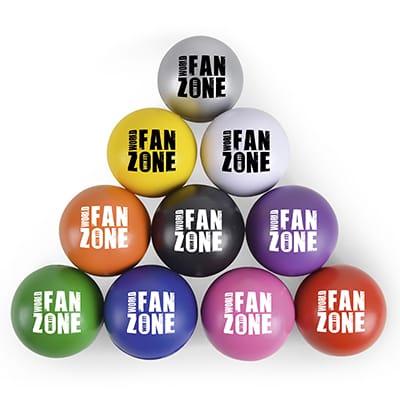
In a curious intersection of corporate wellness and marketing strategy, custom stress balls have surged to become the promotional product of choice for companies across multiple industries, according to recent industry reports.
Garrett Specialties, a veteran in the promotional products industry, reports that orders for personalized stress relievers have increased by nearly 43% over the past 18 months. This growth significantly outpaces other traditional promotional categories like pens, mugs, and tote bags.
"We're seeing a fundamental shift in how companies approach branded merchandise," explains the founder of GarrettSpecialties.com. "There's growing recognition that items should offer genuine utility while carrying a brand message. Custom stress balls hit that sweet spot perfectly."
The timing aligns with concerning workplace trends. The American Psychological Association's 2025 Work and Well-being Survey found that 78% of American workers report experiencing work-related stress, with 44% describing their stress levels as "severe" or "extreme" - both figures representing all-time highs.
What makes this trend particularly noteworthy is how companies are moving beyond basic spherical shapes to create promotional stress balls with logo—reflecting their brand identity and industry focus.
Technology companies favor computer and smartphone-shaped stress relievers, while healthcare organizations lean toward heart-shaped and brain-shaped options. Construction firms typically order hard hat and tool-shaped stress relievers. Some financial institutions have even commissioned custom stress balls shaped like miniature bank buildings or dollar signs, providing a whimsical touch to an otherwise serious industry.
"The product has evolved far beyond the basic round ball," notes the merchandising director at Garrett Specialties. "We now offer more than 400 different shapes and styles that companies can customize with their logos and messaging."
Industry analysts point to several factors driving this trend. An organizational psychologist at Northwestern University explains the psychological appeal: "The tactile sensation of squeezing something provides immediate stress relief through physical release. Having these items prominently displayed on desks creates a subtle reminder about stress management while simultaneously keeping brand imagery in constant view."
Market research firm PromoInsights reports that custom stress balls have among the highest recipient retention rates of any promotional product, with 73% of recipients keeping them for at least 14 months.
What's particularly striking about the custom stress ball phenomenon is its cross-industry appeal. While tech startups and high-pressure financial firms were early adopters, the trend has expanded to sectors not traditionally associated with high-stress environments.
Educational institutions have become significant purchasers, with many colleges distributing branded stress relievers during finals weeks. Government agencies have also embraced the trend, particularly those serving public-facing roles where employee burnout has been problematic.
"Our municipal clients find them especially valuable," says a representative from Garrett Specialties. "Public-facing government employees often deal with frustrated citizens, and having these simple stress relievers accessible provides both a symbolic and practical tool for managing those interactions."
Healthcare organizations represent another growth segment. Hospitals and medical practices now regularly include custom stress balls in wellness initiatives for both staff and patients. Recent innovations have even introduced antimicrobial coatings for these products, addressing hygiene concerns in medical settings.
The economic appeal of custom stress balls also contributes to their popularity. With promotional product budgets under increasing scrutiny, marketers are gravitating toward items offering maximum impact at reasonable price points.
"When you consider cost-per-impression, stress balls represent exceptional value," explains a marketing consultant. "Unlike digital ads that disappear instantly or direct mail that gets tossed, a well-designed stress ball sits on a desk generating thousands of brand impressions over its lifetime."
Production innovations have also improved customization capabilities while keeping costs stable. Advanced printing techniques now allow for more detailed designs and multi-color logos even on uniquely shaped items. Some manufacturers have even developed options that incorporate scents designed to enhance calming effects, such as lavender and chamomile infusions.
As sustainability concerns influence purchasing decisions, manufacturers have responded with eco-friendly options. Garrett Specialties reports that orders for biodegradable and recycled material stress balls have doubled year-over-year.
"Companies increasingly request our earth-friendly options," their product specialist notes. "We've developed stress balls made from recycled materials, corn starch derivatives, and even biodegradable compounds that maintain the same feel and durability as traditional products."
Industry forecasts suggest the custom stress ball trend shows no signs of slowing. Market research firm PromoInsights projects continued growth of 12-15% annually for the next three years.
"As long as workplace stress remains a significant issue—and all indicators suggest it will—we expect continued strong demand," says a company spokesperson. "They're not just promotional products anymore; they've become workplace wellness tools with a marketing component."
For businesses interested in exploring custom stress balls for their promotional needs, Garrett Specialties offers comprehensive consultation services to help companies select designs that align with their brand values and target audience preferences.
While no promotional product alone can solve the underlying issues driving workplace stress, these simple squeezable items appear to have found their place at the intersection of brand marketing and employee well-being—a small but tangible acknowledgment of modern workplace pressures.